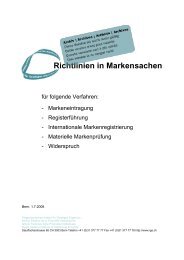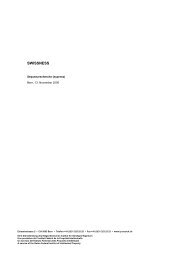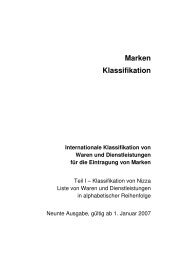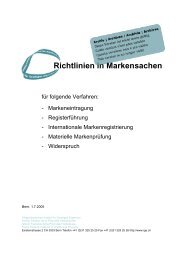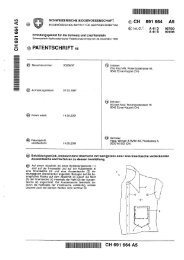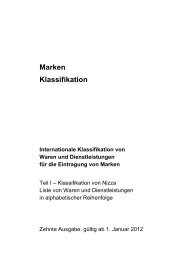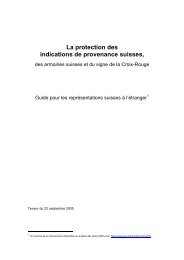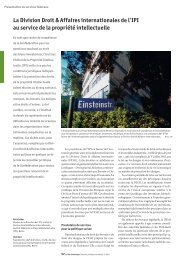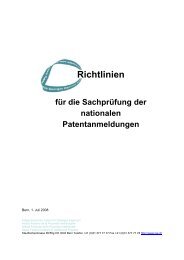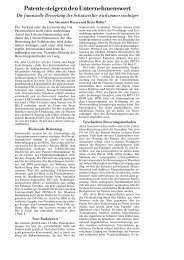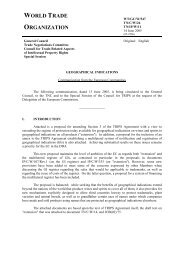AVIS DE DROIT PROTECTION DES SIGNES NATIONAUX
AVIS DE DROIT PROTECTION DES SIGNES NATIONAUX
AVIS DE DROIT PROTECTION DES SIGNES NATIONAUX
Create successful ePaper yourself
Turn your PDF publications into a flip-book with our unique Google optimized e-Paper software.
ETATS-UNIS<br />
5. Protection du signe national «suisse»<br />
Swiss Flag, Coat of Arms, Insignia or other National Symbols<br />
When the United States Patent and Trademark Office (“USPTO”) receives requests for<br />
protection under Article 6ter of the Paris Convention from the International Bureau (“IB”),<br />
they are assigned serial numbers in the "89" series code, i.e., serial numbers beginning with<br />
the digits "89," and are sometimes referred to as "non-registrations." The USPTO searches its<br />
records for conflicting marks, but the requests are not subjected to a full examination by an<br />
examining attorney or published for opposition. Copies of the designations are filed in the<br />
paper records of the Trademark Search Library, and pertinent information is entered in the<br />
automated search records of the Office.<br />
As discussed more fully under section 2(b) above, a mark which consists of or comprises<br />
the flag, coat of arms or other insignia of Switzerland will not be registrable under U.S.<br />
trademark law. 403 Marks which disparage, falsely suggest a connection with, or bring<br />
into contempt or disrepute any Swiss national symbol will similarly be refused<br />
registration. 404<br />
Please note that U.S. Customs & Border Protection (CBP), a bureau of the Department of<br />
Homeland Security, maintains a trademark recordation system for marks registered at<br />
the United States Patent and Trademark Office. Parties who register their marks on the<br />
Principal Register may record these marks with CBP, to assist CPB in its efforts to prevent<br />
the importation of goods that infringe registered marks. The recordation database includes<br />
information regarding all recorded marks, including images of these marks. CBP officers<br />
monitor imports to prevent the importation of goods bearing infringing marks, and can access<br />
the recordation database at each of the 317 ports of entry.<br />
In October 2005, CBP released the Intellectual Property Rights e-Recordation (IPRR) system.<br />
This new system allows right holders to electronically file IPR recordation applications, thus<br />
significantly reducing the amount of time normally required to process paper applications.<br />
Some additional benefits of the new system include:<br />
– Elimination of paper applications and supporting documents.<br />
– Copies of the certificate issued by the registering agency (U.S. Patent and<br />
Trademark Office or the Copyright Office) are retained by the right holder, not<br />
submitted to CBP.<br />
– Payment by credit card (preferred), check or money order.<br />
– Ability to upload images of the protected work or trademark, thus obviating the need<br />
to send samples to CBP.<br />
– Reduced time from filing of the application to enforcement by field personnel.<br />
There is also a federal law specifically addressing protection of the coat of arms of the Swiss<br />
Confederation. 18 U.S.C.A. § 708 provides:<br />
403 15 U.S.C. § 1052(b).<br />
404 15 U.S.C. § 1052(a).<br />
223



